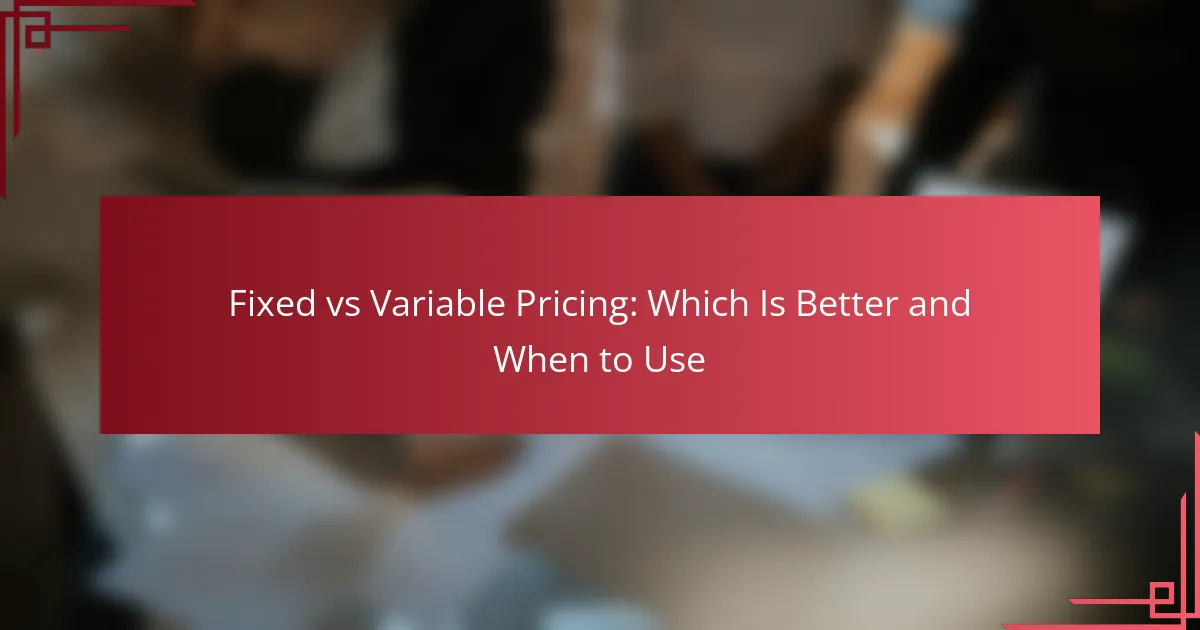Understanding the differences between fixed and variable pricing is crucial for businesses aiming to optimize their pricing strategies. Fixed pricing provides stability and predictability, making it ideal for projects with well-defined scopes and stable demand. In contrast, variable pricing allows for flexibility and responsiveness to market conditions, potentially increasing profits in dynamic environments. Knowing when to use each model can significantly impact a company’s financial success.
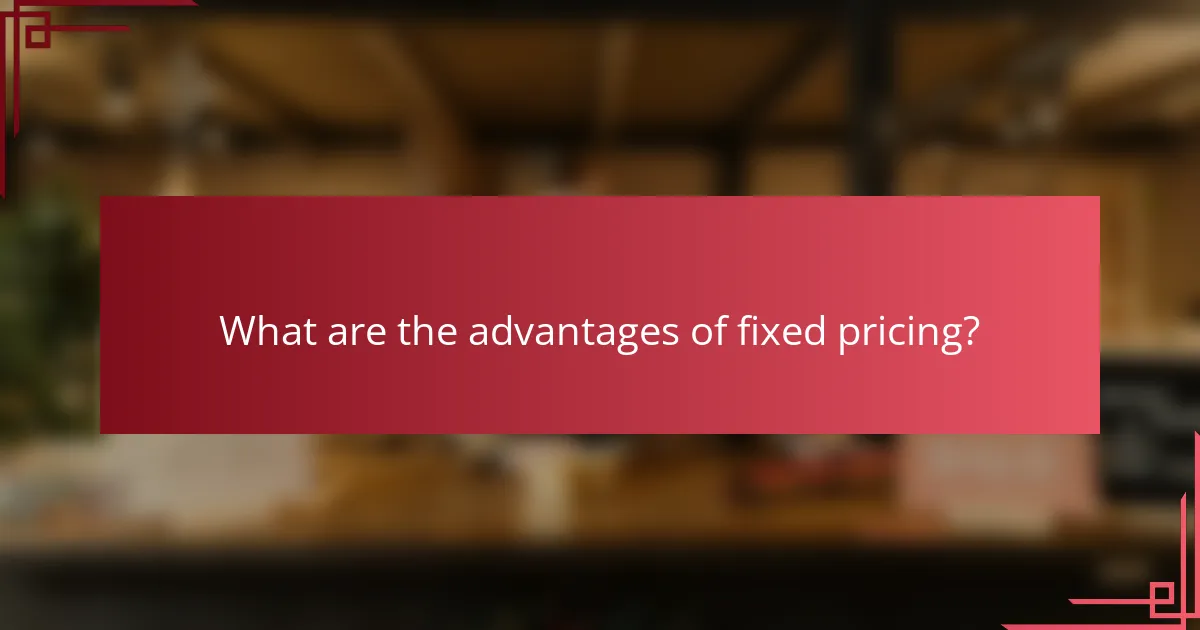
What are the advantages of fixed pricing?
Fixed pricing offers several benefits, including stability and predictability for both service providers and clients. This pricing model allows businesses to establish clear costs upfront, which can enhance trust and simplify financial planning.
Predictable revenue stream
With fixed pricing, businesses can anticipate their revenue more accurately. This model eliminates fluctuations in income that may arise from variable pricing, allowing for better cash flow management. For example, a company charging a set fee for services can forecast monthly earnings, making it easier to plan for expenses and investments.
Simple budgeting for clients
Clients appreciate fixed pricing because it simplifies their budgeting process. Knowing the exact cost upfront helps clients allocate their resources more effectively without worrying about unexpected charges. This transparency can lead to stronger client relationships, as clients feel more secure in their financial commitments.
Reduced negotiation time
Fixed pricing minimizes the time spent on negotiations between service providers and clients. When prices are set, both parties can focus on the scope of work rather than haggling over costs. This efficiency can lead to quicker project initiation and a more streamlined workflow.
Ideal for long-term contracts
Fixed pricing is particularly advantageous for long-term contracts, where stability is crucial. Clients often prefer this model for extended engagements, as it locks in costs and protects against price increases. For service providers, it ensures a steady income over the contract’s duration, allowing for better resource allocation and planning.
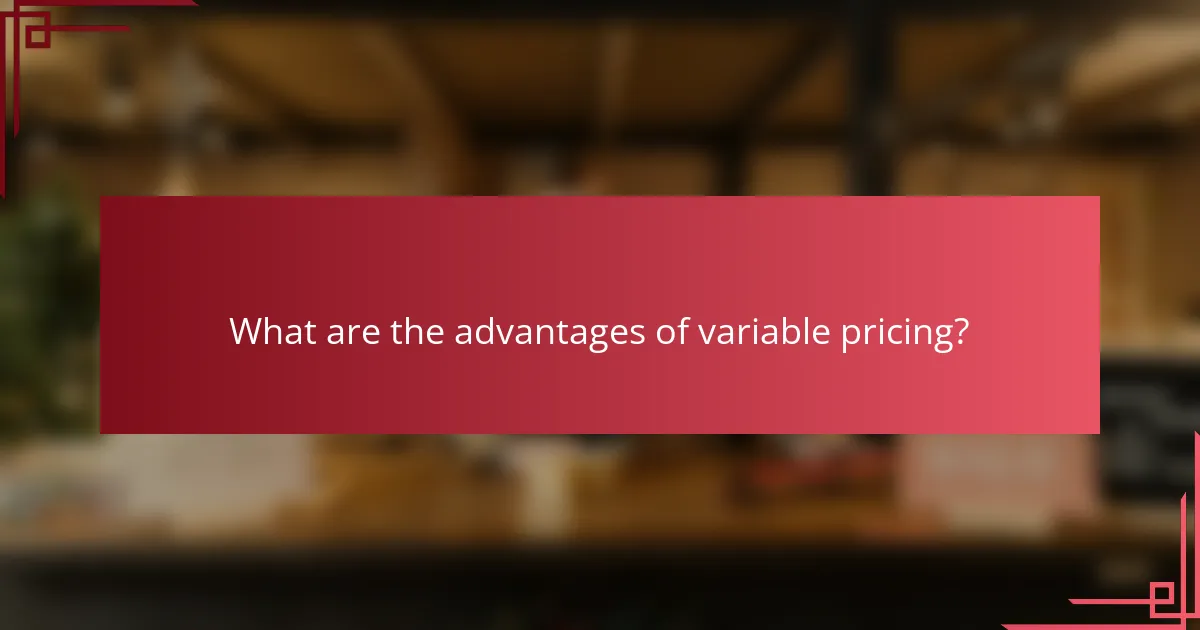
What are the advantages of variable pricing?
Variable pricing offers businesses the ability to adjust prices based on market demand, competition, and customer behavior. This approach can lead to increased profits and a broader customer base, making it a strategic choice in dynamic markets.
Flexibility to adjust to market conditions
Variable pricing allows companies to respond swiftly to changes in market conditions, such as fluctuations in demand or shifts in competitor pricing. For instance, during peak seasons, businesses can raise prices to maximize revenue, while lowering them during off-peak times to stimulate sales.
This flexibility is particularly beneficial in industries like travel and hospitality, where prices can vary significantly based on seasonality and booking trends. Companies that effectively manage their pricing strategies can maintain competitiveness and optimize their revenue streams.
Potential for higher profits
By implementing variable pricing, businesses can capitalize on customers’ willingness to pay more during high-demand periods. This strategy can lead to profit margins that are significantly higher than those achieved through fixed pricing models.
For example, airlines often use variable pricing to adjust ticket prices based on factors like time until departure and seat availability. This can result in profit increases of several percentage points compared to a flat pricing strategy.
Attracts diverse customer segments
Variable pricing can cater to a wide range of customer preferences and budgets, attracting different segments of the market. By offering various price points, businesses can appeal to both price-sensitive customers and those willing to pay a premium for added value.
For instance, a software company might offer a basic version of its product at a lower price while charging more for premium features. This tiered approach not only broadens the customer base but also enhances customer satisfaction by providing options that meet varying needs.
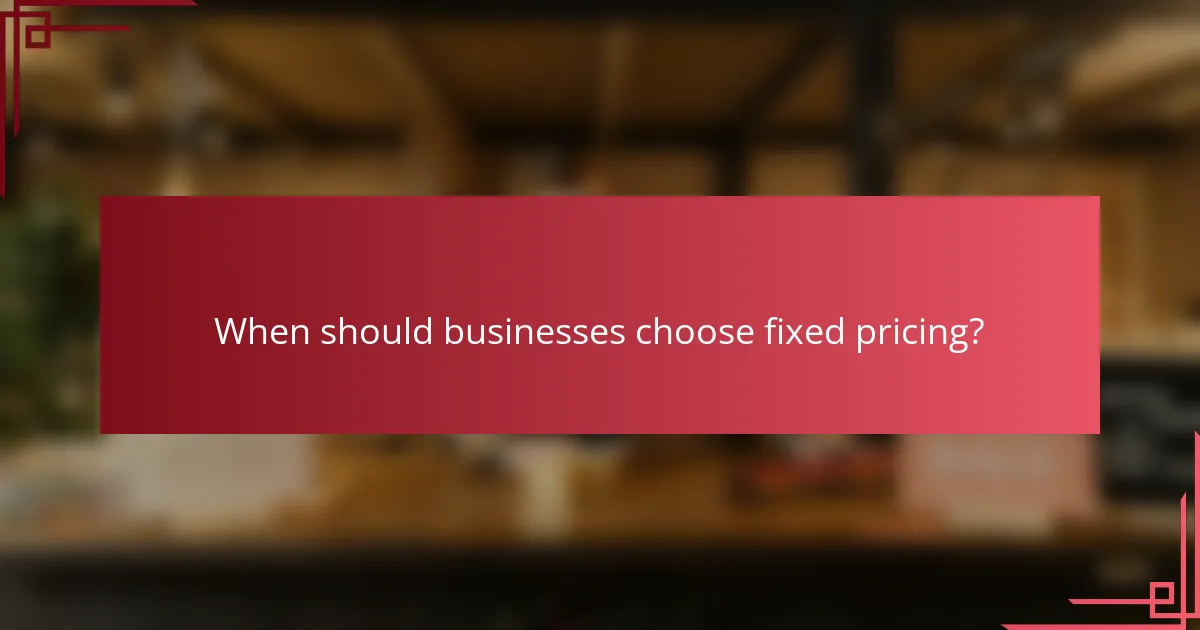
When should businesses choose fixed pricing?
Businesses should choose fixed pricing when they seek predictability in revenue and cost management. This pricing model is particularly beneficial in scenarios where demand is stable and project scopes are well-defined.
Stable demand environments
In stable demand environments, fixed pricing provides a clear framework for both businesses and customers. When demand remains consistent, businesses can confidently set prices that reflect their costs and desired profit margins without worrying about fluctuations.
For example, a subscription service with a steady user base can implement fixed pricing to ensure predictable revenue. This approach allows for easier budgeting and financial forecasting.
Long-term service agreements
Long-term service agreements often benefit from fixed pricing as they establish a clear cost structure over the contract duration. This pricing model helps both parties avoid unexpected costs and fosters trust in the business relationship.
For instance, a facility management company may offer a fixed price for a multi-year maintenance contract, ensuring that clients know their expenses upfront. This can lead to better client retention and satisfaction.
Projects with clear scopes
When projects have clearly defined scopes, fixed pricing can be an effective choice. This model allows businesses to outline specific deliverables and timelines, reducing the risk of scope creep and budget overruns.
For example, a construction firm can provide a fixed price for building a residential property, as the project specifications are well understood. This clarity helps in managing client expectations and ensuring timely project completion.
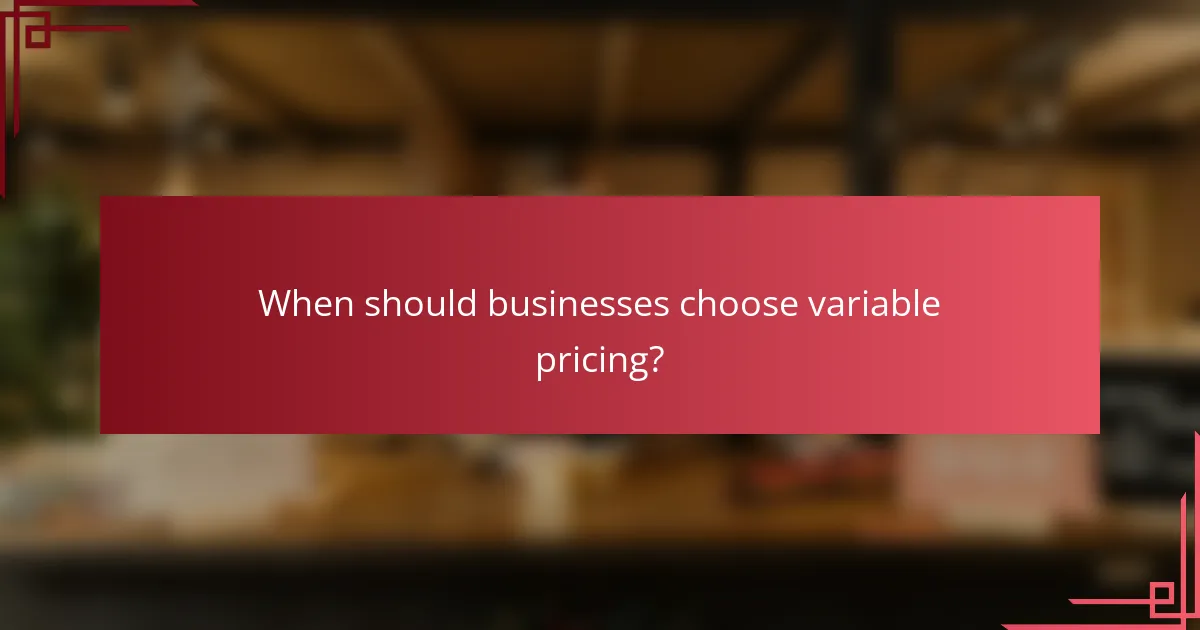
When should businesses choose variable pricing?
Businesses should consider variable pricing when they need flexibility to respond to market conditions, customer demand, or project specifics. This pricing model allows for adjustments based on various factors, making it suitable for dynamic environments.
Highly competitive markets
In highly competitive markets, variable pricing can help businesses remain agile and responsive to competitors’ pricing strategies. Companies can adjust their prices based on real-time market analysis, ensuring they remain attractive to potential customers. For instance, a restaurant may offer discounts during off-peak hours to draw in more patrons.
Projects with uncertain scopes
For projects where the scope is not clearly defined, variable pricing can provide a safety net for businesses. This approach allows for adjustments as project requirements evolve, which is common in industries like construction or software development. A client may initially request a basic service, but as the project progresses, additional features or changes may arise, necessitating price adjustments.
Seasonal demand fluctuations
Variable pricing is particularly effective in industries that experience seasonal demand fluctuations, such as tourism or retail. Businesses can increase prices during peak seasons to maximize revenue and lower them during off-peak times to stimulate sales. For example, a hotel might charge higher rates during summer months when demand is high and offer discounts in the winter to attract guests.
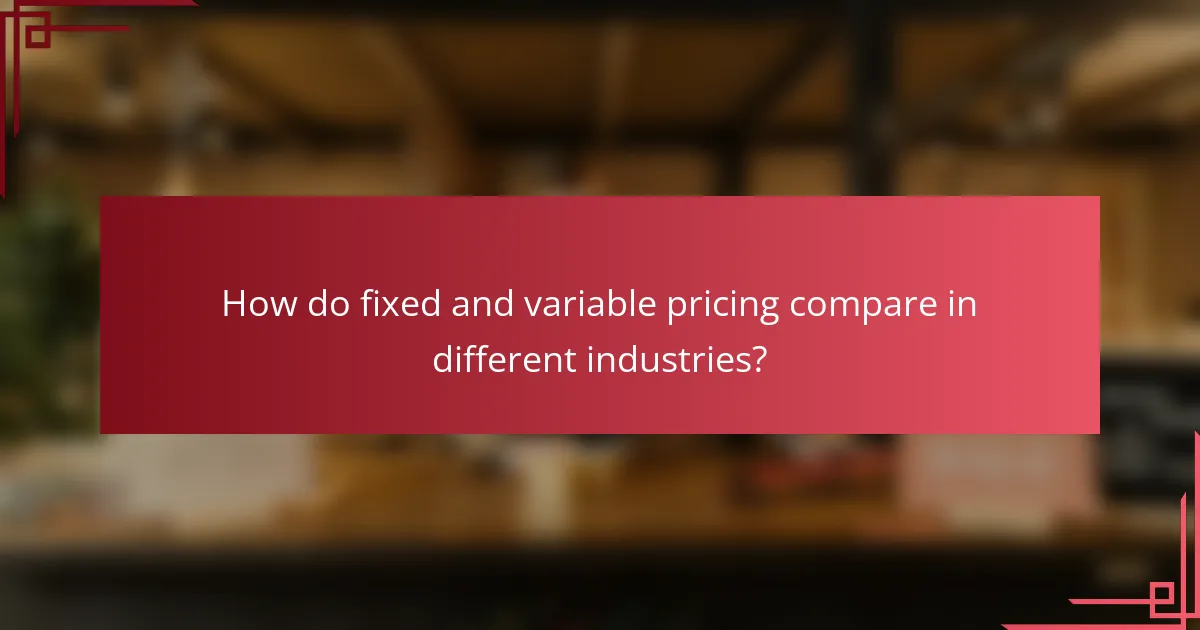
How do fixed and variable pricing compare in different industries?
Fixed and variable pricing models serve distinct purposes across various industries. Fixed pricing offers predictability and stability, while variable pricing allows for flexibility and responsiveness to market changes.
Fixed pricing in construction
In the construction industry, fixed pricing is commonly used for projects where the scope and specifications are clearly defined. This model provides clients with a clear budget, reducing the risk of unexpected costs. For example, a contractor may offer a fixed price for building a home based on detailed plans and materials.
However, fixed pricing can lead to challenges if project requirements change or unforeseen issues arise. Contractors must carefully assess risks and include contingencies in their bids to protect against potential losses.
Variable pricing in software as a service
Variable pricing is prevalent in the software as a service (SaaS) industry, where pricing often depends on usage levels or features selected. This model allows companies to scale their costs with customer needs, making it attractive for startups and small businesses. For instance, a SaaS provider might charge a lower base fee with additional costs based on the number of users or data storage used.
While variable pricing can attract a wider range of customers, it may also lead to unpredictable expenses for users. Companies should clearly communicate pricing structures and potential costs to avoid customer dissatisfaction and ensure transparency.
